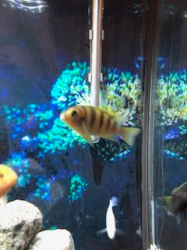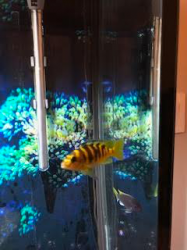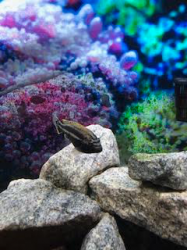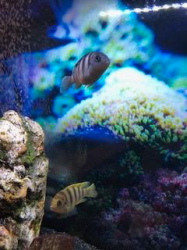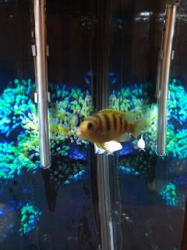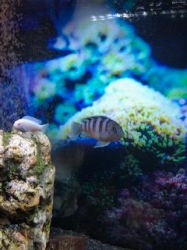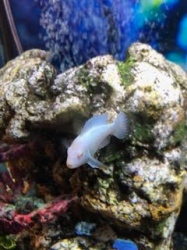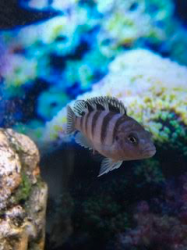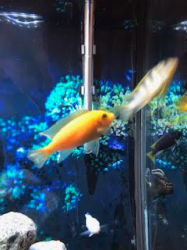You are using an out of date browser. It may not display this or other websites correctly.
You should upgrade or use an alternative browser.
You should upgrade or use an alternative browser.
Cichlid Identification
- Thread starter Dwool40
- Start date
yellow with stripes looks like a male Pseudotropheus Lombardoi.
blue with stripes looks like a female P. lombardoi.
black fish with a white line looks like Pseudotropheus auratus.
white fish looks like an albino Pseudotropheus zebra.
yellow fish without stripes looks like a yellow zebra.
they are all really angry fish when they mature and having males and females will make them worse when they breed.
blue with stripes looks like a female P. lombardoi.
black fish with a white line looks like Pseudotropheus auratus.
white fish looks like an albino Pseudotropheus zebra.
yellow fish without stripes looks like a yellow zebra.
they are all really angry fish when they mature and having males and females will make them worse when they breed.
yellow with stripes looks like a male Pseudotropheus Lombardoi.
blue with stripes looks like a female P. lombardoi.
black fish with a white line looks like Pseudotropheus auratus.
white fish looks like an albino Pseudotropheus zebra.
yellow fish without stripes looks like a yellow zebra.
they are all really angry fish when they mature and having males and females will make them worse when they breed.
Thanks for the assistance. Is all males ok? They’ve already started some breeding behavior and I’ve noticed the increase in aggression.
You have been so helpful. One last question. My yellow zebra (is this the same as a a lab) has white spots on the anal fin. They are very symmetrical. I believe I read this is normal with Cichlids? Have you heard of this ?Most people that have cichlid tanks generally have all males so they get the colour but no babies. You can also have all females but most female cichlids aren't as colourful.
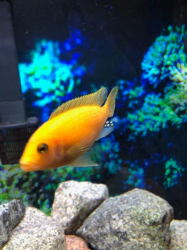
The yellow zebra cichlid is a Pseudotropheus zebra, whereas the electric yellow cichlid is Labidochromis caeruleus. The electric yellow has a slightly different colour of yellow, and black colouration in the dorsal, pelvic and anal fins.
The white spots on the anal fin are egg spots. Lots of male mouth brooding cichlids have these egg spots. Mouth brooding cichlids hold the developing eggs and newly hatched babies in a buccal pouch (little sack under her bottom jaw). When the eggs are laid, the female swims around and picks them up in her mouth and holds them in her buccal pouch. While she is swimming around she sees the egg spots on the male's anal fin and thinks they are eggs. She goes to collect the eggs and when she tries to grab the eggs, the male releases sperm, which gets drawn into the female's mouth and fertilises the eggs in her mouth.
The white spots on the anal fin are egg spots. Lots of male mouth brooding cichlids have these egg spots. Mouth brooding cichlids hold the developing eggs and newly hatched babies in a buccal pouch (little sack under her bottom jaw). When the eggs are laid, the female swims around and picks them up in her mouth and holds them in her buccal pouch. While she is swimming around she sees the egg spots on the male's anal fin and thinks they are eggs. She goes to collect the eggs and when she tries to grab the eggs, the male releases sperm, which gets drawn into the female's mouth and fertilises the eggs in her mouth.
Ok. That’s the coolest thing I’ve heard in a while.The yellow zebra cichlid is a Pseudotropheus zebra, whereas the electric yellow cichlid is Labidochromis caeruleus. The electric yellow has a slightly different colour of yellow, and black colouration in the dorsal, pelvic and anal fins.
The white spots on the anal fin are egg spots. Lots of male mouth brooding cichlids have these egg spots. Mouth brooding cichlids hold the developing eggs and newly hatched babies in a buccal pouch (little sack under her bottom jaw). When the eggs are laid, the female swims around and picks them up in her mouth and holds them in her buccal pouch. While she is swimming around she sees the egg spots on the male's anal fin and thinks they are eggs. She goes to collect the eggs and when she tries to grab the eggs, the male releases sperm, which gets drawn into the female's mouth and fertilises the eggs in her mouth.
Similar threads
- Replies
- 2
- Views
- 208
- Replies
- 5
- Views
- 136
- Replies
- 22
- Views
- 1K

